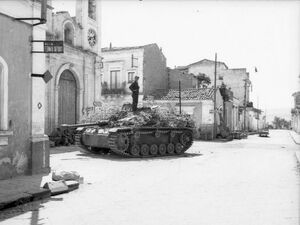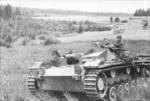The StuG III, Sturmgeschütz III, or SdKfz 142 was an assault gun used by Germany during World War II. It is based on the Panzer III chassis
It is the second most produced German AFV of the war with roughly 10,000 were built in all versions and variants. It saw service in all fronts until war's end. Post war StuGs were used by the Syrian Army until the late 1960's.
Description[]
It had a Panzer III chassis and it also had a 300 hp, gasoline-powered, water-cooled, Maybach HL120 TRM Engine capable of propelling the StuG III at speeds of up to 40.2 km/h (25 mph).[1]
The first model of the StuG III was the Ausf. A and it was produced in limited numbers. The StuG III also had a torsion bar suspension system and a ten speed forward, one speed reverse transmission. The armor protection of the StuG III varied between 50 mm and 30 mm in most areas of the vehicle, but some areas like the bottom only had around 16 mm of armor.
The StuG III Ausf. A had a four-man crew and weight of about 19,323 kg. The length was 5.3 meters and the width was 2.9. The armament of the StuG III was a 75 mm main gun and a MG 34. The StuG could also carry about forty-four rounds for its main gun and 600 rounds for its machine gun. The fuel capacity was 310.4 liters and the maximum range was about 136.7 kilometers.
Variants[]

A StuG III Ausf. G operating in Italy
The StuG III had a number of variants with the first being the Ausf. B. It had a new 6 speed forward, 1 speed reverse transmission and it could carry about 320 liters of fuel.[2] The StuG III Ausf. B also had the same number of crew members and the same FuG 15 radio. The length was 5.4 meters and the weight was about 20,000 kg.
The Ausf. C was based on the Panzer III Ausf. G chassis and it had some minor changes made to the gunner hatch. Other than that, it was very similar to the Ausf. A. The main difference is that all of the StuG III variants have is the 6 speed forward, 1 speed reverse transmission rather than the original 10 speed forward, 1 speed reverse transmission.
The Ausf. D was based on the Panzer III Ausf. H chassis and it was very similar to the Ausf. A, just like the Ausf. C. The next model of the StuG III was the Ausf. E. It had very minor differences compared to the other variants and the main difference were slightly modified panniers. The Ausf. F had a new L/43 main gun and it had improved armor. It also had the same radio as all of the other StuGs and the same crew of 4. Some later models of the StuG III Ausf. F had the L/48 main gun. These models were designated the Ausf. F/8. The last model of the StuG III, the Ausf. G had improved armor and a torsion bar suspension system like the Ausf. F. Its main gun was the 75mm L/48 and it engine was the same as all other StuG IIIs.
History[]

A StuG III in the Soviet Union
The StuG III entered production in 1940 and it upgunned the original Panzer III. Not only that, but it was cheaper and easier to make.[3] At first, only 30 Ausf. As were made and they first saw combat during the Invasion of France. Later models were produced in greater quantities and eventually, thousands were made. StuG IIIs were effective in supporting infantry and they were used in places like Stalingrad and Normandy.
The StuG III was also effective at the tank killing role and served this role throughout the war. One of its key characteristics that allowed it to excel in these types of roles was its low siloutte making it harder to be hit by other vehicles and the fact that it was designed for supporting infantry, meaning that it would be highly effective in urban areas like stalingrad.
References[]
| |||||||||||||||||||||||
